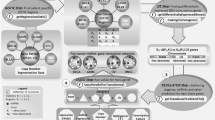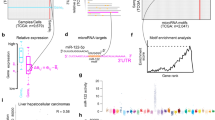Abstract
We demonstrate that paired expression profiles of microRNAs (miRNAs) and mRNAs can be used to identify functional miRNA-target relationships with high precision. We used a Bayesian data analysis algorithm, GenMiR++, to identify a network of 1,597 high-confidence target predictions for 104 human miRNAs, which was supported by RNA expression data across 88 tissues and cell types, sequence complementarity and comparative genomics data. We experimentally verified our predictions by investigating the result of let-7b downregulation in retinoblastoma using quantitative reverse transcriptase (RT)-PCR and microarray profiling: some of our verified let-7b targets include CDC25A and BCL7A. Compared to sequence-based predictions, our high-scoring GenMiR++ predictions had much more consistent Gene Ontology annotations and were more accurate predictors of which mRNA levels respond to changes in let-7b levels.
This is a preview of subscription content, access via your institution
Access options
Subscribe to this journal
Receive 12 print issues and online access
$259.00 per year
only $21.58 per issue
Buy this article
- Purchase on Springer Link
- Instant access to full article PDF
Prices may be subject to local taxes which are calculated during checkout



Similar content being viewed by others
References
Engels, B.M. & Hutvagner, G. Principles and effects of microRNA-mediated post-transcriptional gene regulation. Oncogene 25, 6163–6169 (2006).
Krek, A. et al. Combinatorial microRNA target predictions. Nat. Genet. 37, 495–500 (2005).
Enright, A.J. et al. MicroRNA targets in Drosophila. Genome Biol. 5, R1 (2003).
Lewis, B.P., Burge, C.B. & Bartel, D.P. Conserved seed pairing, often flanked by adenosines, indicates that thousands of human genes are microRNA targets. Cell 120, 15–20 (2005).
Long, D. et al. Potent effect of target structure on microRNA function. Nat. Struct. Mol. Biol. 14, 287–294 (2007).
Kertesz, M., Iovino, N., Unnerstall, U., Gaul, U. & Segal, E. The role of site accessibility in microRNA target recognition. Nat. Genet. 39, 1278–1284 (2007).
Wu, W., Sun, M., Zou, G.M. & Chen, J. MicroRNA and cancer: Current status and prospective. Int. J. Cancer 120, 953–960 (2006).
Lu, J. et al. MicroRNA expression profiles classify human cancers. Nature 435, 834–838 (2005).
He, L. et al. A microRNA polycistron as a potential human oncogene. Nature 435, 828–833 (2005).
Johnson, S.M. et al. RAS is regulated by the let-7 microRNA family. Cell 120, 635–647 (2005).
Hammond, S.M. MicroRNAs as oncogenes. Curr. Opin. Genet. Dev. 16, 4–9 (2006).
Bagga, S. et al. Regulation by let-7 and lin-4 miRNAs results in target mRNA degradation. Cell 122, 553–563 (2005).
Lim, L.P. et al. Microarray analysis shows that some microRNAs downregulate large numbers of target mRNAs. Nature 433, 769–773 (2005).
Farh, K.K. et al. The widespread impact of mammalian MicroRNAs on mRNA repression and evolution. Science 310, 1817–1821 (2005).
Huang, J.C., Morris, Q.D. & Frey, B.J. Bayesian inference of MicroRNA targets from sequence and expression data. J. Comput. Biol. 14, 550–563 (2007).
Stark, A., Brennecke, J., Bushati, N., Russell, R.B. & Cohen, S.M. Animal MicroRNAs confer robustness to gene expression and have a significant impact on 3′ UTR evolution. Cell 123, 1133–1146 (2005).
Ramaswamy, S. et al. Multiclass cancer diagnosis using tumor gene expression signatures. Proc. Natl. Acad. Sci. USA 98, 15149–15154 (2001).
Camon, E. et al. The Gene Ontology Annotation (GOA) Database: sharing knowledge in Uniprot with Gene Ontology. Nucleic Acids Res. 32, D262–D266 (2004).
Cangi, M.G. et al. Role of the Cdc25A phosphatase in human breast cancer. J. Clin. Invest. 106, 753–761 (2000).
Wu, W., Fan, Y.H., Kemp, B.L., Walsh, G. & Mao, L. Overexpression of cdc25A and cdc25B is frequent in primary non-small cell lung cancer but is not associated with overexpression of c-myc. Cancer Res. 58, 4082–4085 (1998).
Mailand, N. et al. Rapid destruction of human Cdc25A in response to DNA damage. Science 288, 1425–1429 (2000).
Kent, W.J. et al. The human genome browser at UCSC. Genome Res. 12, 996–1006 (2002).
Acknowledgements
J.C.H. and T.B. were supported by Natural Science and Engineering Research Council postgraduate scholarships. T.W.C. was supported by a Canada Graduate Scholarship from the Canadian Institutes for Health Research (CIHR). This study was supported by a Natural Sciences and Engineering Research Council operating grant and Canadian Foundation for Innovation and Ontario Research Fund infrastructure grants to Q.D.M.; a CIHR grant to B.J.F. and T.R.H; an Ontario Genomics Institute and Genome Canada grant to B.J.F. and B.J.B.; a CIHR and National Cancer Institute of Canada grant to B.J.B.; and a US National Institutes of Health grant to B.L.G. B.J.F. is a Fellow of the Canadian Institute for Advanced Research.
Author information
Authors and Affiliations
Corresponding authors
Supplementary information
Supplementary Text and Figures
Supplementary Figures 1–6, Supplementary Tables 1–2, Supplementary Methods (PDF 2123 kb)
Rights and permissions
About this article
Cite this article
Huang, J., Babak, T., Corson, T. et al. Using expression profiling data to identify human microRNA targets. Nat Methods 4, 1045–1049 (2007). https://doi.org/10.1038/nmeth1130
Received:
Accepted:
Published:
Issue Date:
DOI: https://doi.org/10.1038/nmeth1130
This article is cited by
-
The Transcription Factor, α1ACT, Acts Through a MicroRNA Network to Regulate Neurogenesis and Cell Death During Neonatal Cerebellar Development
The Cerebellum (2022)
-
BITS2019: the sixteenth annual meeting of the Italian society of bioinformatics
BMC Bioinformatics (2020)
-
An improvement of ComiR algorithm for microRNA target prediction by exploiting coding region sequences of mRNAs
BMC Bioinformatics (2020)
-
Extracellular vesicle-associated miR-135b and -135a regulate stemness in Group 4 medulloblastoma cells by targeting angiomotin-like 2
Cancer Cell International (2020)
-
Transcriptome analysis of miRNA and mRNA in the livers of pigs with highly diverged backfat thickness
Scientific Reports (2019)



